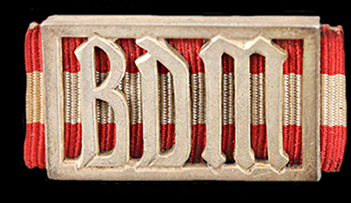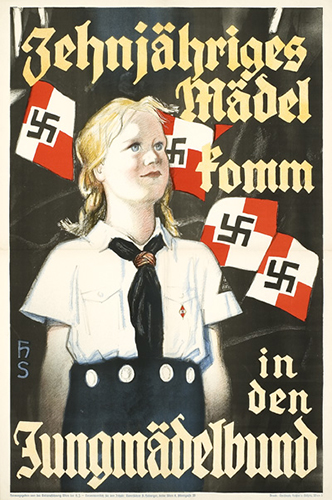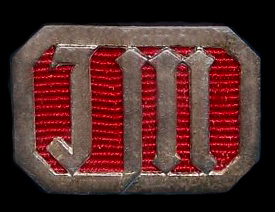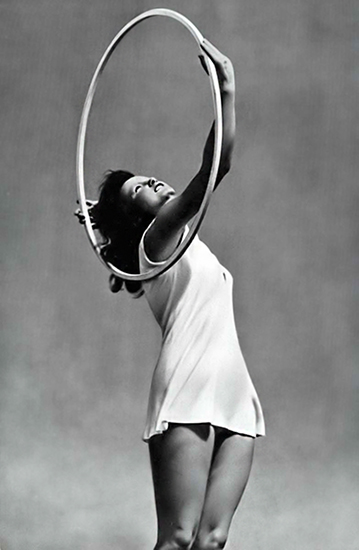
The League of German Girls
(Bund Deutscher Mädel - BDM)
League of German Girls (Bund Deutscher Mädel/BDM), was the girls' wing of the Nazi Party youth movement, the Hitler Youth. It was the only female youth organization in Nazi Germany.
The BDM was run directly by HJ leader and Reichsjugendführer Baldur von Schirach until 1934, when Trude Mohr, a former postal worker, was appointed to the position of BDM-Reichsreferentin, or National Speaker of the BDM and directly reported to the Reichsjugendführer. After Mohr married in 1937, she was required to resign her position (the BDM required members to be unmarried and without children in order to remain in leadership positions), and was succeeded by Dr. Jutta Rüdiger, a doctor of psychology from Düsseldorf, who was a more assertive leader than Mohr but nevertheless a close ally of Schirach, and also of his successor from 1940 as HJ leader, Artur Axmann. She joined Schirach in resisting efforts by the head of the NS-Frauenschaft (Nazi Woman's League), Gertrud Scholtz-Klink, to gain control of the BDM. Rüdiger led the BDM until its dissolution in 1945.
At the beginning of World War II, the Reichsarbeitsdienst became compulsory also for young women. It lasted half a year. Many young women became 'Blitzmädel' ('Wehrmachthelferin' or female workers in the armed forces) during World War II.
Organization
The League consisted of three sections:
Jungmädel, or Young Girls' League, for girls ages 10 to 14
League of German Girls (Bund Deutscher Mädel/BDM) for girls ages 14 to 18.
Faith and Beauty Society (BDM-Werk Glaube und Schönheit), which was voluntary and open to girls between the ages of 17 and 21.

Bund Deutscher Mädel proficiency clasp - Bronze

Bund Deutscher Mädel proficiency clasp - Silver
Young Girls' League
(Jungmädelbund)
The Jungmädelbund (Young Girl's League) was the section of the Hitler Youth for girls between the ages of 10 and 14.
After the Gleichschaltung in 1933, the League of German Girls became the only girls' organization in the Third Reich. All other groups, including church groups and scouting organizations, were either absorbed into the Hitler Youth or banned. In 1936, the First Hitler Youth Law made membership compulsory for all girls aged 10 or older. The same law also made membership in the male Hitler Youth compulsory for all boys above the age of 10.
New members had to register for their service between March 1st and March 10th of every year. Registration was held at a local League of German Girls administrative office. Girls had to have completed fourth grade and meet the following requirements:
Be of racial/ethnic German heritage
Be a German citizen
Be free of hereditary diseases
If a girl met those requirements, she was assigned to a Jungmädel group based on the geographical location she lived at. In order to become a full member, she had to now attend preparatory service which consisted of her participation of one Jungmädel meeting, one sports afternoon which was to include a test of her courage, and a lecture about the tasks of the Jungmädel.
After she fulfilled these requirements, a ceremony was held to introduce new members into the rank of the Jungmädel on April 20th, Hitler's birthday. During the ceremony, new members were sworn in, presented with a membership certificate, and personally welcomed by their group leaders.
In order to become a "full" member, however, each girl had to pass the Jungmädel Challenge (Jungmädelprobe), which consisted of participation in a one-day trip with the group, and a number of sports requirements. Girls had six months to meet all the requirements of the Jungmädel Challenge and, on October 2nd of each year, those who passed became full members in another ceremony in which they were officially presented with the right to wear the black neckerchief and brown leather knot.
A girl was then a full member of the Jungmädel and remained in the group until the age of 14, at which point she transferred into the League of German Girls.

Jungmädelbund poster

Jungmädelbund proficiency clasp
Faith and Beauty Society
(Werk Glaube und Schönheit)
The Faith and Beauty Society was founded in 1938 to serve as a tie-in between the League of German Girls and the Nazi Frauenschaft. The idea was that girls should be part in the work for the whole Volksgemeinschaft before they went on to either jobs or, ideally, to marry and have children.
Membership was voluntary and open to girls aged 17 to 21. The work in the Society was mainly geared toward priming the girls for their tasks as wives and mothers, and while courses offered ranged from fashion design to healthy living, the overall idea was to teach them home economics so they would properly run their households, cook well for their families, and care properly for their children.
According to Dr. Jutta Rüdiger, who had taken over as the leader of the League of German Girls in 1937:
"The task of our Girls League is to raise our girls as torch bearers of the national-socialist world. We need girls who are at harmony between their bodies, souls, and spirits. And we need girls who, through healthy bodies and balanced minds, embody the beauty of divine creation. We want to raise girls who believe in Germany and our leader, and who will pass these beliefs on to their future children."
